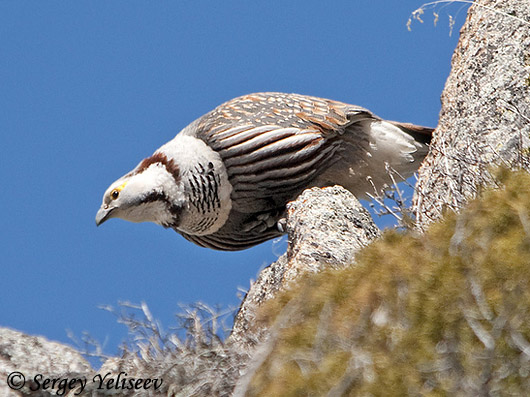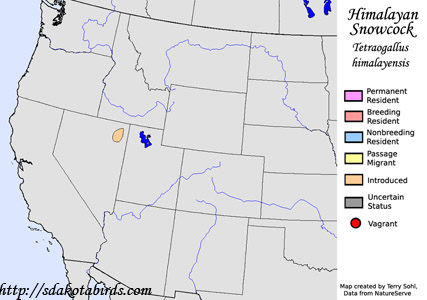| Length: 26 - 29 inches | Wingspan: 36 inches | Seasonality: Non-resident in South Dakota |
| ID Keys: Grayish overall, white face and throat, chestnut streaks on throat and head, chestnut stripes on flanks | ||
 The
Himalayan Snowcock is a very large, pheasant-like species that is native to
central and southern Asia. On its native range, they are typically
found at very high elevations on mountain slopes, ranging as high as 18,000
feet in the summer, and wintering between 7,000 and 12,000 feet. The
species was introduced as a gamebird in the Ruby and East Humboldt Mountains
of Nevada beginning in the 1960s, with continued stockings occurring through
the 1970s. A small but self-perpetuating population is now established
in the area, with an estimated population of between 300-600 birds.
The
Himalayan Snowcock is a very large, pheasant-like species that is native to
central and southern Asia. On its native range, they are typically
found at very high elevations on mountain slopes, ranging as high as 18,000
feet in the summer, and wintering between 7,000 and 12,000 feet. The
species was introduced as a gamebird in the Ruby and East Humboldt Mountains
of Nevada beginning in the 1960s, with continued stockings occurring through
the 1970s. A small but self-perpetuating population is now established
in the area, with an estimated population of between 300-600 birds.
Habitat: Himalayan Snowcocks are found on high elevation slopes and pastures above treeline. In their introduced range in Nevada, they are found in alpine and subalpine areas.
Diet: Feeds on grasses, sedges, forbs, seeds, roots, and tubers.
Behavior: Daily routines for the species typically includes walking up mountain slopes during the day while foraging, then flying/gliding back down the mountain to roost for the evening. Foraging is done on the ground.
Nesting: Himalayan Snowcocks are monogamous, with the female incubating the eggs and doing the majority of tending to the young. Family groups may stay together through the fall and into the winter.
Song: Birds that are alarmed or disturbed will often take flight and make a loud, repeating weet-weet-weet-weet call. Various cackling calls are also heard.
Migration: Not truly migratory, although elevational shifts may occur, with birds moving to lower elevations in the winter.
Interactive eBird Map: Click here to access an interactive eBird map of Himalayan Snowcock sightings
Similar Species: Distinctive, size, structure and plumage make it unlikely to be confused with other species.
Conservation Status: Populations of the Himalayan Snowcock in the Ruby Mountains of Nevada appear to be stable and self-sustaining. Little spread of the population has been noted outside of the introduced range in the Ruby and East Humboldt mountains. In their native range in Asia, populations appear to be stable, and the species is considered a species of "least concern" by the IUCN.
Further Information: 1) Audubon - Guidebook - Himalayan Snowcock
2) GBWF.org - Himalayan Snowcock
3) Backpacking in the Ruby Mountains - Himalayan Snowcock
Photo Information: May 23rd, 2010 - Almaty region of Kazakhstan - Sergey Yeliseev - Photo licensed under Creative Commons Attribution-NonCommercial-NoDerivs 2.0 Generic license.
| Click below for a higher-resolution map |
 |
| South Dakota Status: Non-resident in South Dakota |
Additional Himalayan Snowcock Images (coming soon!)
